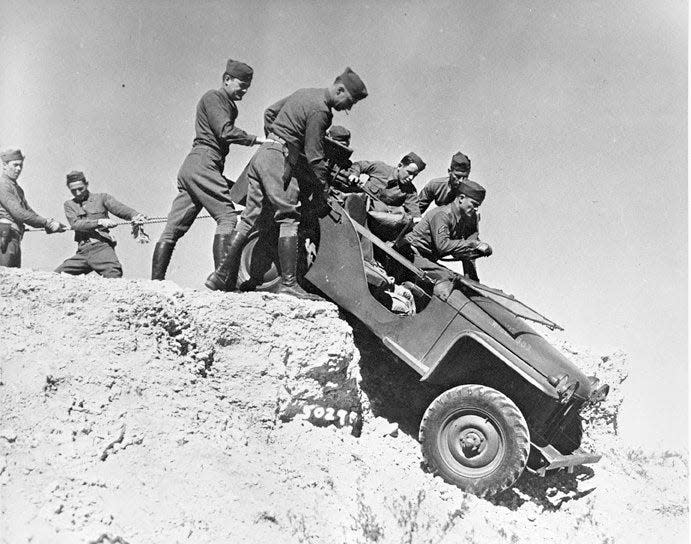Fort Bliss cavalrymen helped test 'jeeps' for Army in 1940s
This article first appeared in the April 29, 1956, Diamond Jubilee edition of the El Paso Times:
Cavalrymen eyed jeeps with scorn
One bright autumn morning in 1941, about 35 men gathered around four odd-looking little vehicles and two trucks on the post at Fort Bliss.
The men were trying to get used to the new name of their outfit, the 1st Reconnaissance Squadron, made up from the 1st Armored Car Company.
The outfit was not old itself, having recently been formed with men picked from the 5th, 12th, 7th and 8th Cavalry and the 82nd Field Artillery.
The little vehicles these men of the 1st Reconnaissance gathered around were squat, low-to-the-ground cars with canvas tops and knobby tires. They were known familiarly as “Bantams” and officially as General Purpose Vehicles.

G.P.s became jeeps
The official designation soon was to become “G.P.s” and then “jeeps” in Army parlance.
But now they were Bantams. The 1st Reconnaissance, which included a young private named T.W. (Ted) Elkins, was given the job of testing the first four of them at Fort Bliss.
Elkins thinks the four may have been the first four jeeps the Army had. Certainly, they were experimental models, not yet in mass production.
Maj. Luther Anderson, present public information officer at Fort Bliss, thinks there were several teams of jeeps, tested in various parts of the U.S. in different climatic conditions.
At any rate, Elkins, now an El Paso city policeman, and his buddies probably viewed the little four-cylinder cars with some skepticism that morning.
More: El Paso WWII veterans remember horror, heroism of D-Day in 2009 interviews: Trish Long
One model steered with four wheels
These were horse-cavalrymen, many of them unwilling for the coming mechanization of the cavalry and doubtful of its wisdom.
It was hard for men to love machines, especially these little ugly ducklings with their four-wheel drive, which was supposed to make them climb hills like flies and flounder through mudholes like ducks. One of the experimental models even steered with all four wheels.
The two trucks, which accompanied the four jeeps, were the men’s homes for two weeks. A field kitchen went along to supply their food.
Thus equipped, the cavalrymen started their two-week punishment of the Bantams ‒ punishment designed to see whether the new “G.P.s” could take it.
From the Hueco Range to Arizona the men pushed the cars day and night through desert sand, mountain snows, rocky hillsides and flowing streams.
More: Pat Garrett's gun skills the talk of Coney Island: Trish Long
Worked too well
The four-wheel steering jeep turned out to be capable of such sharp turns that several times it landed in ditches because the driver had turned the steering wheel a fraction of an inch too far.
The men drove and rode the eight hours, then slept in the accompanying trucks. Only for fuel and oil did the jeeps come to halts during those grueling 14 days of punishment.
The trucks with their sleeping men took the easy ways, stuck to highway and made better time so the men could sleep better, but the jeeps were forced across country and along backroads little improved since the mule wagon and ox cart days.
The jeeps made the grade and the Army put them at once in mass production.
More: General of the Army Dwight ‘Ike’ Eisenhower visited El Paso in 1946, liked Mexican food
Unit become 91st Reconnaissance
Shortly after the test runs, the Army discovered that it already had a 1st Reconnaissance Squadron and renamed the Fort Bliss unit the 91st Reconnaissance.
Under this name, the unit hit Africa, used to its jeeps now, proud of them, leading the infantry in them.
After Africa, Elkins and his outfit were sent to Sicily, and again the 91st was at the front and sometimes beyond. On one scouting expedition, Elkins was riding the rear of a scout car manning a 50-caliber machine gun when a German soldier tossed a “potato masher” grenade directly into the auto.
The grenade landed on the car’s radio, exploded, killed the driver and wounded two others in the machine. Elkins alone was uninjured.
The three survivors were captured by the Germans. Elkins and one of the wounded, who was able to walk, were marched away. The other wounded GI was left for advancing American troops to care for.
That was 1943.
Jeep becomes a household name
In 1945, 22 months after he was captured, Elkins was liberated from a noncommissioned officers’ prisoner of war camp in East Germany by the Russians.
During those 22 months the little cars he had helped test had covered most of the world with their knobby tire tracks.
They had crawled through the jungles of the South Pacific and Burma, crept up icy mountains in Italy, wallowed through mudholes from Normandy to Berlin.
Jeep had become a household word in America.
With only minor changes, the same vehicle still is in use on American bases and those of America’s allies from one end of the world to the other.
Trish Long may be reached at 915-546-6179 or tlong@elpasotimes.com.
This article originally appeared on El Paso Times: Fort Bliss cavalrymen helped test 'jeeps' for Army in 1940s

